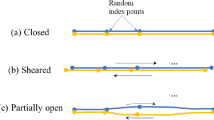Abstract
Asymmetric continuum theory points to the equal roles of the rotation motions and those related directly to shear or confining strains. The strain motions could be quite independent or mutually related with the eventual phase shifts, while the displacements have only a mathematical sense; a real displacement may appear along the fracture slip only. Formally, any deformation could be presented as related to the displacements; however, its origin in a fracture source should be considered either as belonging to an individual process or to complex correlated events; in these cases, the confining, shear and rotation strains can be related mathematically to the different displacement fields. Some of these related deformations could be emitted from a source with a phase shift, while the observed displacements (deduced from records) result as a sum of these independent displacements. An important influence on a source process and on the premonitory micro-events has the material defects, their distribution, and mobility. The defect arrays lead to a concentration of stresses and their local reorganization. Thus, in this paper, we consider the induced stresses and strains related to defect content and to its modification and redistribution. Moreover, an important role in understanding the complex correlated events in a source plays the release–rebound mechanism. The release–rebound mechanism in an earthquake source processes leads to a possible direct or phase-shifted correlations between the emitted motions; in this aspect, a propagation of the coupled strain and rotation waves is discussed. In particular, we consider the point fracture events as related either to a confining load or/and to the shear and rotation processes; we discuss the related effects and their meaning when discussing the fault plane mechanism and emitted waves. In some important seismic regions, we have the recording system which permits to record the strains and rotations. However, we should point that the wordwide seismological network is not adequate to record the complex strain deformations released in the fracture processes and remains quite insufficient to understand the global stress changes and related strain waves of a very low period. Consideration on a recording mechanism of the long displacement waves indicates the insufficiencies of the present global recording system and points that recording of the global strain and rotation waves is an important and urgent task.


Similar content being viewed by others
References
Boratynski W, Teiseyre R (2006) Continuum with rotation nuclei and defects: dislocation and disclination densities. In: Teisseyre R, Takeo M, Majewski E (eds) Earthquake source asymmetry, structural media and rotation effects. Springer, Heidelberg, pp 57–66
Cosserat E, Cosserat F (1909) Théorie des Corps Déformables, A. Hermann et Fils, Paris
Crandall SH, Dahl NC, Lardner TJ (1978) An introduction to the mechanics of solids. McGraw Hill, New York
Droste Z, Teisseyre R (1959) The mechanism of earthquakes according to dislocation theory. Sci Rep Tohoku Univ, Ser 5, Geophys 11(1):55–71
Eringen AC (1999) Microcontinuum field theories. Springer, Berlin
Feng S (1985) Percolation properties of granular elastic networks in two dimensions, on elastic networks: new exponent and threshold. Phys Rev B 32:510–513
Feng S, Sen PN, Halperin BI, Lobb CJ (1984) Percolation on elastic networks: new exponent and threshold. Phys Rev Lett 52:216–219
Gomberg J, Agne D (1996) The accuracy of seismic estimates of dynamic strains: an evaluation using strainmeter and seismometer data from Piñon Flat observatory. Calif Bull Seismol Soc Am 86(1A):212–220
Kossecka E, DeWitt R (1977) Disclination kinematics. Arch Mech 29:633–651
Milanovsky EE (ed) (2007) Rotational processes in geology and physics, scientific literature and textbooks, Moscow, URSS, pp 523
Nowacki W (1986) Theory of asymmetric elasticity. Pergamon Press, New York
Peach M, Koehler JS (1950) The forces exerted on dislocations and the stress fields produced by them. Phys Rev 80:436–439
Roux S, Guyon E (1985) Mechanical percolation: a small beam lattice study. J Physique Lett 46:L-999–L-1004
Shimbo M (1975) A geometrical formulation of asymmetric features in plasticity. Bull Fac Eng Hokkaido Univ 77:155–159
Shimbo M (1995) Non-Riemannian geometrical approach to deformation and friction. In: Teisseyre R (ed) Theory of earthquake premonitory and fracture processes. PWN, Warszawa, pp 520–528
Teisseyre R (1973) Earthquake processes in a micromorphic continuum. Pure Appl Geophys 102:15–28
Teisseyre R (1974) Symmetric micromorphic continuum: wave propagation, point source solutions and some applications to earthquake processes. In: Thoft-Christensen P (ed) Continuum mechanics aspects of geodynamics and rock fracture mechanics. Springer, Heidelberg, pp 201–244
Teisseyre R (1985) New earthquake rebound theory. Phys Earth Planet Inter 39(1):1–4
Teisseyre (2001) Evolution, propagation and diffusion of dislocation fields. In: Teisseyre R, Majewski E (eds) Earthquake thermodynamics and phase transformations in the earth’s interior. Academic, San Diego, pp 167–198
Teisseyre R (2002) Continuum with defect and self-rotation nuclei. Acta Geophys Pol 50:51–68
Teisseyre R (2009) Tutorial on new development in physics of rotation motions. Bull Seismol Soc Am 99(2B):1132–1136
Teisseyre R (2011) Why rotation seismology: confrontation between classic and asymmetric theories. Bull Seismol Soc Am 101(4):1683–1691
Teisseyre R, Górski M (2008) Introduction to asymmetric continuum: fundamental point deformations. In: Teisseyre R, Nagahama H, Majewski E (eds) Physics of asymmetric continua: extreme and fracture processes. Springer, Heidelberg, pp 3–15
Teisseyre R, Górski M (2009a) Fundamental deformations in asymmetric continuum: motions and fracturing. Bull Seismol Soc Am 99(2B):1028–1039
Teisseyre R, Górski M (2009b) Transport in fracture processes: fragmentation and slip. Acta Geophys 57(3):583–599
Teisseyre R, Górski M (2011) Earthquake fragmentation and slip processes: spin and shear-twist wave mosaic. Acta Geophys 59(3):453–469
Vikulin AV (ed.) (2004) Vortex-related events of the geological processes, Russian Ac. Sci., Far East Division, Petropavlovsk-Kamchatsky, pp 383
Zubov LM (2011) Continuum theory of dislocations and disclinations in nonlinearly elastic micropolar media. Mech Solids 46(5):348–3056
Acknowledgments
The author expresses many thanks for the important and inspiring remarks of the anonymous reviewers and hopes that the related improvements have made the presentation more clear.
Author information
Authors and Affiliations
Corresponding author
Rights and permissions
About this article
Cite this article
Teisseyre, R. Rotation and strain seismology. J Seismol 16, 683–694 (2012). https://doi.org/10.1007/s10950-012-9287-6
Received:
Accepted:
Published:
Issue Date:
DOI: https://doi.org/10.1007/s10950-012-9287-6




